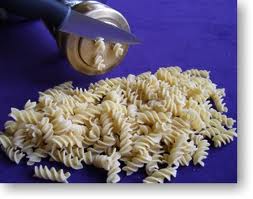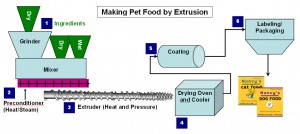- Iams and Eukanuba: Behind The Paw
- P&G’s Behind the Paw Pet Influencer Summit
- Behind the Paw Influencer Summit- Iams Plant Tour
- How is dry kibble made? Iams & Eukanuba Behind the Paw
After my mom returned from the Iams & Eukanuba Behind the Paw summit, I had a lot of questions about how dried kibble is made. I told my mom that just because she has had the opportunity to visit and see behind the scenes at many food manufacturing facilities, doesn’t mean that the rest of us know what an auger in an extruder is or how it works exactly. Have you ever wondered how dry kibble is made?
I bet many of you have eaten an extruded product. Here is a photo of a very common human food that is made by the extrusion process.
The dry kibble at the Iams and Eukanuba plant are also made my the extrusion process. I thought you might like to know that ALL the raw materials, another name for ingredients that are in Iams and Eukanuba dried food are sourced from North America, actually the United States and Canada, except for the lamb and venison that comes from New Zealand.
When all the ingredients have been tested and cleared for processing the kibble is ready to be made. I found a flow chart from the Pet Food Institute and I thought this would help me explain the kibble making process.
Please note, this is not the flow chart from the P&G Leipsic Plant. This is just for me to show you how the extrusion process works.
- All the Ingredients in their proper quantities are placed together in a mixer. Dry ingredients might be ground, for example meat ground into meal, prior to mixing with wet ingredients. After the dry and wet ingredients are mixed, they will form a moist dough.
- The dough may be heated in the pre-conditioner before advancing to the extruder.
- The extruder, is like a big meat grinder or pasta maker. The dough is extruded under intense heat and pressure as the auger moves the dough through a shaping die with a blade that moves in a circular motion cutting the pieces of kibble to just the right size.
- The kibble moves along a conveyer ,where it is dried in an oven reducing the moisture content until the kibble will be shelf stable. That means the kibble will be just fine stored at room temperature. The kibble is then cooled to a precise temperature.
- When cooled, the kibble passes through a machine that adds the flavor that makes the kibble taste good.
- Packages are formed filled and sealed during the last step. Each package is filled to the exact amount to meet the weight advertised on the label and is code dated for quality and safety reasons.
- The finished goods, or packaged kibble are then palletized, shrink wrapped and labeled for shipping to a retailer near you.
I hope you found my extrusion post interesting.
My next post will tackle your questions about ingredients. Thank you for reading.
We received no compensation from P&G other than hotel, transportation, meals and bowling during the
Behind The Paw Summit


Hmm, interesting process. I’m looking forward to hearing about the ingredients. Thanks for the good/ hard work Gracey and mom!!